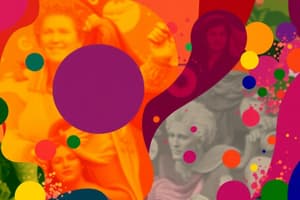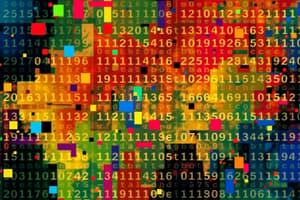Podcast
Questions and Answers
According to the lecture, what is essential for Digital Humanities (DH)?
According to the lecture, what is essential for Digital Humanities (DH)?
- Exclusively focusing on the technical aspects of digital tools.
- A strict adherence to traditional research methodologies.
- Understanding the mathematical, computational, and physical foundations of machines. (correct)
- Avoiding the use of digital tools to maintain a pure humanistic approach.
In the context of the 'chromatic metaphor' used to define Digital Humanities, what does the 'intersection' or 'relationship in-between' refer to?
In the context of the 'chromatic metaphor' used to define Digital Humanities, what does the 'intersection' or 'relationship in-between' refer to?
- The clear and distinct separation of digital and humanistic elements.
- The merging of various color palettes to create a new visual aesthetic.
- The complex and sometimes unclear relationship between digital tools and humanities research. (correct)
- The historical precedence of color theory in the development of digital interfaces.
What approach is suggested for Digital Humanities lessons to fully understand the chromatic metaphor?
What approach is suggested for Digital Humanities lessons to fully understand the chromatic metaphor?
- Reading with a parallel text, integrating technical bases with concrete examples. (correct)
- Isolating the technical bases from their application in concrete scenarios.
- Focusing solely on the sociological implications of digital tools.
- Avoiding historical analysis to maintain focus on current digital trends.
Why does computer science not consist of acquiring computer science knowledge?
Why does computer science not consist of acquiring computer science knowledge?
What is a key aspect of how symbols, such as numbers and letters, gain meaning, according to the lecture?
What is a key aspect of how symbols, such as numbers and letters, gain meaning, according to the lecture?
What fundamental concept is essential when trying to define what makes a world 'digital'?
What fundamental concept is essential when trying to define what makes a world 'digital'?
Why is the definition of computer science as simply 'the science of digital electronic computers' considered too restrictive?
Why is the definition of computer science as simply 'the science of digital electronic computers' considered too restrictive?
What connects digital electronic computers to earlier inventions like Babbage's engine, solidifying their place in the history of computer science?
What connects digital electronic computers to earlier inventions like Babbage's engine, solidifying their place in the history of computer science?
According to the lecture, what was Alan Turing referring to when he wrote about a 'computer'?
According to the lecture, what was Alan Turing referring to when he wrote about a 'computer'?
How did the meaning of the term 'computer' change over time?
How did the meaning of the term 'computer' change over time?
What are the two stops in the etymological path of the word 'digital'?
What are the two stops in the etymological path of the word 'digital'?
What is the significance of the connection between 'digit' and 'digitus' in the context of the lecture?
What is the significance of the connection between 'digit' and 'digitus' in the context of the lecture?
According to the lecture, what is the first way we learn how to count?
According to the lecture, what is the first way we learn how to count?
What does the lecture define as an 'analogy' between two entities?
What does the lecture define as an 'analogy' between two entities?
What is the main distinction between analogue and digital systems, in the context of counting?
What is the main distinction between analogue and digital systems, in the context of counting?
What is a fundamental requirement for communication using digits to be successful?
What is a fundamental requirement for communication using digits to be successful?
Why can images and texts be categorized together from the perspective presented in the lecture?
Why can images and texts be categorized together from the perspective presented in the lecture?
In the context of digital humanities, why is 'encoding' considered the most important activity associated with texts?
In the context of digital humanities, why is 'encoding' considered the most important activity associated with texts?
What is the relationship between encoding, the computer, and decoding, according to the lecture?
What is the relationship between encoding, the computer, and decoding, according to the lecture?
In what key way do abaci, as analog systems, differ from modern digital systems?
In what key way do abaci, as analog systems, differ from modern digital systems?
Flashcards
What is DIGITAL in DH?
What is DIGITAL in DH?
Mathematical, computational, and physical foundations that underlie the functioning of machines.
Chromatic metaphor in DH
Chromatic metaphor in DH
The relationship in-between the components of Digital Humanities, not always a clear boundary.
Charles Babbage's Analytical Engine
Charles Babbage's Analytical Engine
A calculator started in the 19th century, an entirely mechanical calculator capable of basic arithmetic operations.
Concept of Computation
Concept of Computation
Signup and view all the flashcards
Encoding
Encoding
Signup and view all the flashcards
Decoding
Decoding
Signup and view all the flashcards
Analog Systems (Abaci)
Analog Systems (Abaci)
Signup and view all the flashcards
Digital Systems (Encoding)
Digital Systems (Encoding)
Signup and view all the flashcards
Analogy
Analogy
Signup and view all the flashcards
Digital Systems
Digital Systems
Signup and view all the flashcards
Shared Context
Shared Context
Signup and view all the flashcards
Study Notes
Digital Humanities and the Digital Realm
- Digital Humanities involves theoretical and methodological definitions that compare the foundations and differences between its components.
- A scientific approach to "DIGITAL" is necessary, examining the mathematical, computational, and physical foundations of machines.
- Digital Humanities should be viewed as a parallel reading, combining the technical bases of digital tools with their application in understanding problems via historical and sociological perspectives.
- The focus is deepening understanding of the mathematical bases, numbers, and figures that underpin digital endeavors.
Foundations of Digital Concepts
- Key theoretical and philosophical foundations of "digital" and the scientific disciplines that regulate data production and computation can be found in the first four chapters of a book.
- Understanding the core mechanisms of each language enables bidirectional correspondence necessary for co-design work in Digital Humanities.
- Symbolic codes, like numbers, colors, and letters, gain meaning from their context.
Computation and Computer Science
- Computer science is often associated with the first digital electronic computer.
- Computer science, however, can exist separately from digital electronic computers like Charles Babbage’s analytical engine.
- Babbage's analytical engine was an entirely mechanical calculator from the 19th century capable of performing the four basic arithmetic operations.
- Computation is the concept that links digital electronic computers and Babbage's engine.
- Computation refers to the execution of operations on numbers that yield numbers.
- Digital electronic computers use circuits that respond to electrical impulses following the rules of arithmetic.
- Alan Turing viewed a "computer" as a person who computes, and sought to automate computation through machines.
- The term "computer" shifted in meaning as machines became successful, leading to the discipline of "computer science."
Etymology of "Digital"
- This term comes from the modern English "digit," which refers to a sign used to express numbers, which in turn comes from the Latin "digitus," meaning finger.
Analogy vs. Digits
- Fingers offer an analogy for counting by sharing the characteristic of being present and distinct.
- Digits are signs with agreed-upon meanings, unrelated to what they represent.
- The numeral '3' signifies "three" by convention, unlike an analogy.
- Analogue systems rely on analogy, whereas digital systems rely on signs expressing quantities based on established agreements.
Digits and Communication
- The meaning of a digit relies on a shared understanding among users.
- Communication requires a common background or shared context.
- This shared understanding specifies the meaning of each sign allowing for successful transmission and communication.
- This aspect of shared understanding relates to the humanities within digital contexts.
Digital Representation
- Digital depictions of objects like cats, pipes, and watches are not the real things.
- The representation of text is still text, as it visualizes signs allowing images and texts to be grouped together.
Encoding and Decoding
- “Encoding,” or mapping entities onto numbers, is crucial for all digital activity.
- “Decoding” is mapping numbers back to the initial entities.
- Computers operate between encoding and decoding, working with numbers.
- Computers are used by encoding inputs, processing them, and then decoding the outputs.
Analog vs. Digital Systems
- Abaci are analog systems.
- Digital systems use encoding to map entities onto numbers requiring general agreement.
- Babbage's machine was an analog computer.
- Digital computers are now prevalent due to 20th-century discoveries that made them faster and smaller than analog versions.
Studying That Suits You
Use AI to generate personalized quizzes and flashcards to suit your learning preferences.




